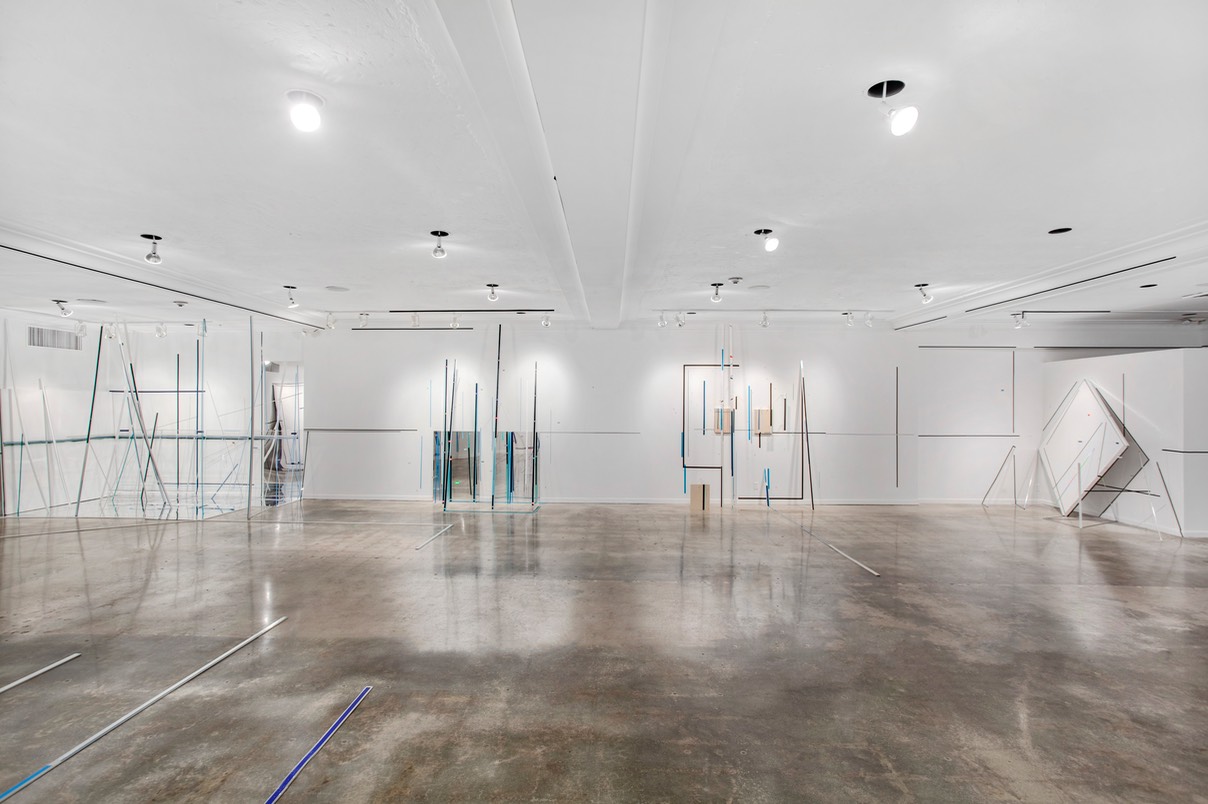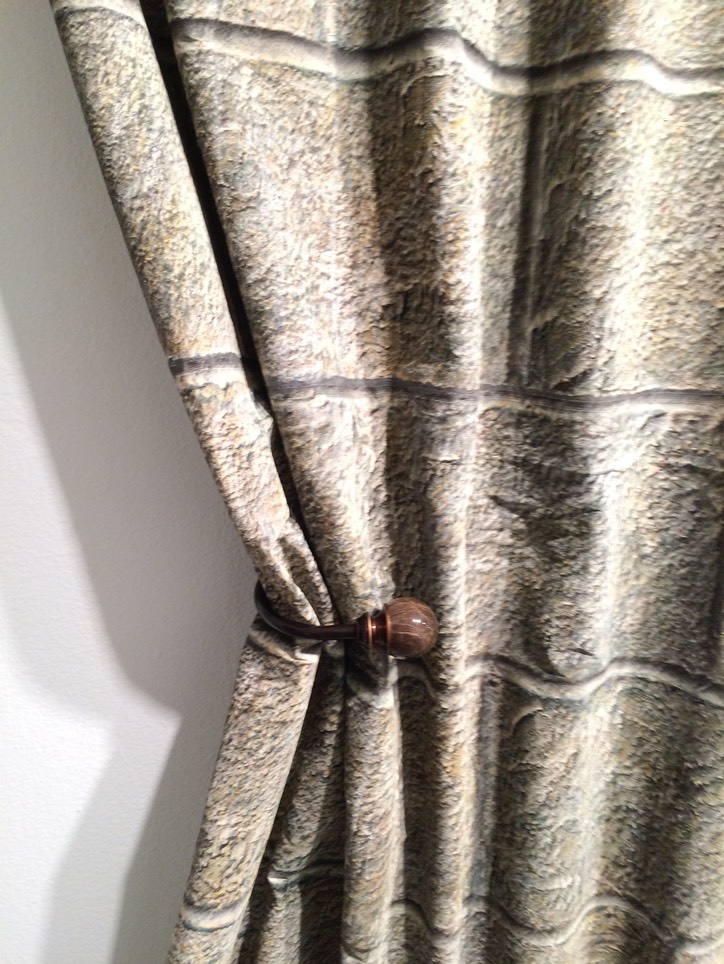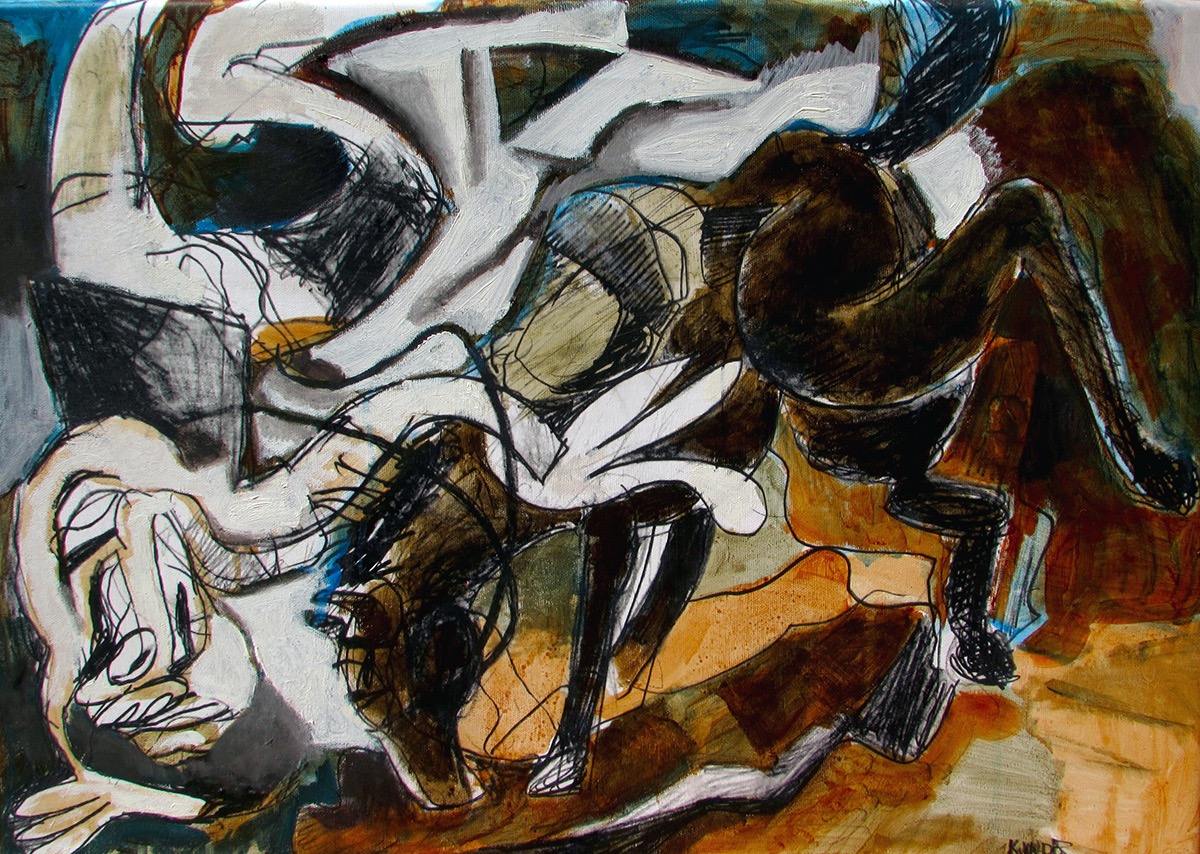Francesco Lo Castro and Kelley Johnson video. CLICK
Francesco Lo Castro on Nolan Haan video. CLICK
Francesco Lo Castro on Maynard Monrow video. CLICK
Francesco Lo Castro on Kiki Valdes video. CLICK
Kelley Johnson’s colorful geometry highlights solo shows at Hollywood arts center
BY GEORGE FISHMAN
george@QRartguide.com
Last fall, when Jane Hart departed after eight years as director of exhibitions at the Art and Culture Center/Hollywood, she left a legacy of strong relationships with artists, fellow curators and institutions. She also left in place exhibition programming through January 2018.
Those commitments are being honored, center director Joy Satterlee assured in a recent interview. However, “life happens” to artists, she said. They move away, get pregnant, sell their work, etc. Consequently, while reviewing applications for a new full-time curator, the center is engaging interim curators to fill empty slots.
For one, the annual Abracadabra fundraiser show was put on hold, so artist and curator Francesco Lo Castro, “a friend of Jane’s and a friend of the center,” offered to step in, selecting two of the five artists currently exhibiting.
Kelley Johnson’s artistic rigor — along with his experimental attitude and the beauty of his radiant color geometry — led Lo Castro to invite him to show in the main gallery. Although the curator had only seen a few isolated pieces, included in Hart’s multi-venue survey exhibition 100+ Degrees in the Shade, he felt respect and affinity for Johnson's work, and “I wanted to see what he could do having an entire room to himself.” Lo Castro also knew that Johnson was relatively unknown in the region.
During a scouting visit, Johnson developed a clear sense of the center’s space and place. In his Miami studio, he developed nine pieces, but only finished them to a point. Then, during a weeklong installation, Lo Castro served as Johnson’s adjutant in adapting the artworks to the space and each other.
The goal was to create a dynamic experience for visitors to mirror the installation’s improvisational nature. It’s called Something That Hovers and Pulses Just Under the Surface.
Johnson initially marked a low horizon line around the room with stripes of tape and spray paint. He wanted to generate a subtle sense “not uncomfortable, but a little offsetting. I think it allows the viewer to not float, but feel lighter.”
Curiously, before the 1924 Mediterranean-style building was bequeathed to the Art Center in 1992, that space had served for 29 years as the chapel of a funeral home. In the exhibition, Johnson and Lo Castro acknowledged both physical markings on the floor from the former seating arrangement and a residual spirit in the architecture.
Lo Castro recounted, “This is the altar and also where the bodies would be shown.” It needed light and airiness and “something that transcends.” Alchemical Starship anchors that curved wall; its parallel stripes of purple and blue point skyward. On the floor, additional stripes radiate, gather and converge. “It’s all about elevating the experience,” Lo Castro said. Without overtly referencing religious or spirit realms, Johnson calls on viewers to question their place in the world — on every level.
Johnson’s sculptural paintings, meticulously fashioned of metal and plastic strips, moldings, mirror and tape, connect to the walls but also reach out — sometimes way out — into the room, animating the space. Walking past them causes radical realignments. One plane obscures another; gaps close and then open; shadows move; mirrors reflect shifting forms; colors connect within and between pieces. “It’s almost like we’re interacting in a dance,” Lo Castro said. “You build the spaces as you walk around,” Johnson said.
The artist’s affinity for assembling structures dates back to childhood involvement in construction. Framing houses provided an immersive experience of making networks of vertical and horizontal “sticks,” which then became spaces. The shifting juxtapositions of rafters, joists, two-by-fours and thinner moldings constituted a daily experience of orientation, proportion and illusion that informed his artistic study and current practice. As a student, Joseph Albers, Frank Stella, Ellsworth Kelly and the Russian constructivists were all influences, although Johnson also painted in a figurative mode.
Each piece in the show simultaneously joins the collective and remains distinctive. Starburst stands kite-like on its “tail” and is uniquely painted with veils of modulating pastel colors. Two of the three Untitled works are also fundamentally planar. Both Something That Pulses and Push Pull Slide Click feature two small wall-mounted rectangular panels and one on the floor, interwoven with stripes. But they contrast sharply in their use of subtle vs. brilliant color.
From most angles, Flickering and Floating appears constructed around two small doorways into an adjacent room. But then someone walks past and reveals the mirror illusion. Disorientation is even stronger in the corner-mounted Stage Sketch for Reverse Mobile. Wall and floor mirrors generate ever-changing illusions of space and surface, creating a miniature “fun house” within the overall installation.
Johnson’s drawings in space proliferate without clearly defined borders. Despite its industrial precision, linear proportions, often intense color and reflective surfaces, the installation has an organic living quality. Some “breathe” outward, others “inward,” as visitors circulate the room. It’s not like swimming through a coral reef, but more like viewing an array of iridescent spider webs, a meteor shower or kaleidoscope display.
“I think that what Kelley does is take traditional elements to create these virtual spaces, without really having to rely on technology,” Lo Castro said. “Step into the space and see what’s possible with just a little bit of imagination and some tape and canvas and wood.”
The adjacent Middle Gallery features Hart’s invité, Nolan Haan, whose play on moral challenge is called The Futility of Envy. Self-taught as a portrait painter while serving in the Peace Corps, Haan gained success as a wildlife artist but now is best known for trompe l’oeil paintings of concrete blocks.
Taking his skill beyond decoration, in this show he bestows consciousness on these inert objects, proposing that, like us, they could be subject to envy. A cinder block wishes it were something else: a stone wall, stop sign, lace, curtain. Each piece, says Lo Castro, is a meditation on that theme. “They're all shape-shifted into something that they are not.” And while appearing to have knobbly, fuzzy or grainy textures, they are actually flat — hyper-realistically painted on silk.
COMMENTARY ON MODERN LIFE
Still Life is a modest-scaled exhibition by New York-based artist Maynard Monrow, whom Hart has known for 20 years. In common usage, a still life is a drawing, painting or photo of objects: wilting flowers, silverware, an hourglass, perhaps a dead bird. Monrow offers a different take.
Using the vintage signage format of plastic letters, pushed into a grooved felt-covered board, his brief cryptic phrases mostly evoke situations, rather than objects. STILL LIFE ESCORTING THE LIONIZED CANONIZED AND OUTCAST, for example. "To me they bring in current events; they bring in revolutionary kinds of imagery — etiquette, rhetoric and other kinds of guerrilla tactics,” Lo Castro proposed. STILL LIFE WITH FAUX PATRIOTS BRANDISHING PROPAGANDA. “It just reminds me of what's going on in the political debates at the moment," Lo Castro said.
Monrow leaves the viewer to generate specific references, which may be more vivid and personal than whatever imagery he might have depicted pictorially. Comparing Haan with Monrow, Hart said, “Their aesthetics are not the same, but they share in selecting unconventional, alternative types of materials and installation practices.”
CARTOONS FOR NOW
Kiki Valdes’ paintings in the Project Room exhibit titled Cowboys, Cartoons Obstructions and More initially appear more conventional. They might have been conceived in the 1920s — in the company of Picasso and Rufino Tamayo. But then a mid-century pop reference appears: in Davis, a Donald Duck figure slides off a horse and tangles with another fat-fingered character.
"He is heavily influenced by past movements — especially by turn-of-the-century cubism, abstract expressionism and others,” Lo Castro said. "He draws from these older movements of modern art and combines them with the aesthetic of the cartoon. He mixes them all up together and creates these of-the-moment, contemporary pieces that carefully balance the past and the present.”
His rodeo scenes suggest the hero’s struggle against authority. These 2014-15 works intermingle the fun-house mood of a Disney caper with de Kooning’s contorted women. Yet, for all the powerful influences Valdes has absorbed, his voice is distinctive — whether in diminutive canvases or in broad strokes across tufted elevator blankets.
FROM THE STREET
On the Run is the title of Rocky Grimes’ installation on the Landing, a small “introductory showcase” that Hart implemented. Grimes’ work is largely print based and strongly oriented toward the low-tech and hand-made. He came of age with Miami’s punk rock/skateboard scene and maintains the DIY attitude of Zine culture. He burns his own snapshots onto screens and has done performance-like printing on the street from a pushcart.
His wall assemblage at the center is a tightly packed, plastic crazy quilt, consisting of roughly three dozen boxy constructions and motley found objects. His imagery juxtaposes miniature busy patterning, duo-tone palm silhouettes, night skies, lace and chain-link fencing; there’s a Mickey Mouse head, rainbow-hued holographic soccer ball and a hooded face. Day-glo color predominates.
The diversity of elements and the show’s title derive in part from his M.O. of collecting objects and images from the street. “He wakes up and takes a morning run,” explained Lo Castro, and everything — whether a Private Property sign, construction cone, scouring pad or snapshot — has been gathered along the artist’s neighborhood streets in Homestead and Florida City.
Through scores of exhibitions, Hart’s wide-ranging curatorial aesthetic — especially for the “family-friendly” audiences of the center — has consistently balanced a high level of sophistication with accessibility. “I was trying to carry along,” Lo Castro concluded, “and keep true to her vision. She's a good friend, and hopefully we did her justice.” Michelle Weinberg and Jill Weisberg will also be guest artist-curators.
So far, so good.


